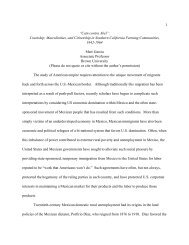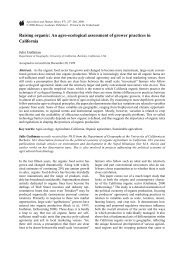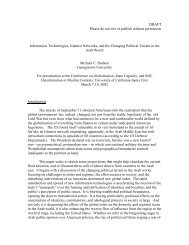The Death of Ramon Gonzalez and the 21st Century Dilemma
The Death of Ramon Gonzalez and the 21st Century Dilemma
The Death of Ramon Gonzalez and the 21st Century Dilemma
You also want an ePaper? Increase the reach of your titles
YUMPU automatically turns print PDFs into web optimized ePapers that Google loves.
maintain a relationship with families <strong>and</strong> home communities because <strong>of</strong> <strong>the</strong> dangers <strong>of</strong><br />
crossing back over <strong>the</strong> border. And <strong>the</strong> casualty rate climbs.<br />
Thous<strong>and</strong>s <strong>of</strong> communities such as <strong>Ramon</strong> <strong>Gonzalez</strong>’s home village <strong>of</strong> San<br />
Jeronimo Progreso were already sending most <strong>of</strong> <strong>the</strong> able-bodied men <strong>and</strong> many women<br />
<strong>and</strong> children out on <strong>the</strong> migrant trail before NAFTA was contemplated. After <strong>the</strong> passage<br />
<strong>of</strong> NAFTA, a more general ab<strong>and</strong>onment <strong>of</strong> farms in Mixtec, Zapotec, <strong>and</strong> mestizo<br />
villages has proceeded apace. While <strong>the</strong> farms are ab<strong>and</strong>oned <strong>and</strong> village people seek<br />
work along <strong>the</strong> migrant trail in Mexico <strong>and</strong> <strong>the</strong> United States, in some villages, including<br />
San Jeronimo Progreso, <strong>the</strong>re is a boom in <strong>the</strong> construction <strong>of</strong> new houses. Migrants pay<br />
<strong>the</strong> relatively few stay-at-homes to build houses to which <strong>the</strong> migrants hope to return for<br />
<strong>the</strong> annual fiesta <strong>and</strong>/or to which <strong>the</strong>y dream <strong>of</strong> returning in old age. ix<br />
In some villages, though not apparently in San Jeronimo Progreso, farms are not<br />
only being ab<strong>and</strong>oned but are being sold to o<strong>the</strong>rs, including to Mexicans outside <strong>the</strong><br />
region <strong>and</strong> to foreigners. Prior to 1992, Article 27 <strong>of</strong> <strong>the</strong> Mexican Constitution prohibited<br />
<strong>the</strong> sale <strong>of</strong> ejido <strong>and</strong> communal l<strong>and</strong>s distributed by <strong>the</strong> government. This was part <strong>of</strong> <strong>the</strong><br />
l<strong>and</strong> reform program started at <strong>the</strong> end <strong>of</strong> <strong>the</strong> Mexican Revolution in <strong>the</strong> early 20 th<br />
century. Article 27 also made it difficult for foreigners to own l<strong>and</strong>. In 1992, partly in<br />
response to U.S. objections to Article 27 restrictions, <strong>the</strong> Mexican Congress <strong>and</strong><br />
President approved sweeping changes to Article 27. <strong>The</strong>se changes made <strong>the</strong> U.S. more<br />
enthusiastic about pursuing <strong>the</strong> NAFTA negotiations. <strong>The</strong> so-called “reform <strong>of</strong> <strong>the</strong> [l<strong>and</strong>]<br />
reform” made it possible for l<strong>and</strong> reform recipients in ejidos <strong>and</strong> communes to sell <strong>the</strong>ir<br />
l<strong>and</strong>. Farmers could now mortgage <strong>the</strong>ir l<strong>and</strong>s <strong>and</strong> thus have better access to credit.<br />
(Government rural credit programs to those on ejidos had long been virtually eliminated





